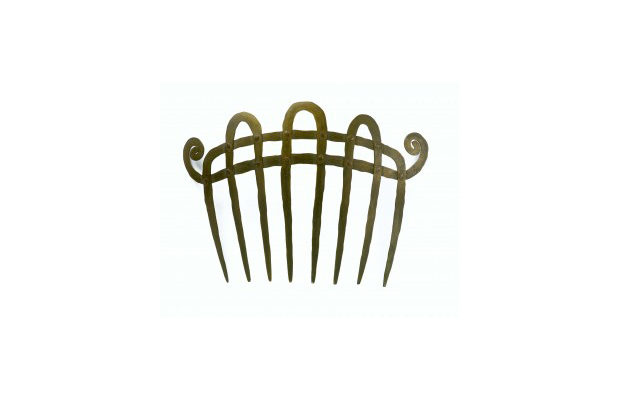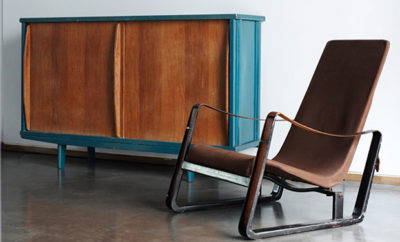
Design
The New Art de Vivre: Five Dealers in Artist Jewelry Discuss the Market

Michele Oka Doner’s Coral Reef necklace in 22-karat gold dates from 2005; Afsoun.
While Tiffany and Cartier diamonds have long dazzled buyers internationally, lately modern and contemporary artist jewelry has been commanding center stage on the museum and the gallery scene. MODERN Magazine spoke to five dealers in artist jewelry to learn how they see the market developing—and to catch a glimpse of their offerings. All say the Museum of Arts and Design (MAD) in New York has been a leader in the field by establishing a separate department devoted to this jewelry.
Longtime Design Miami participants Martine and Didier Haspeslagh, whose gallery Didier Ltd. is located in London, focus on postwar jewelry by painters and sculptors. “Trailblazing museum exhibitions are crucial to exposing entire new audiences to the field,” Martine says. She points to MAD’s 2011–2012 From Picasso to Koons: The Artist as Jeweler show, which traveled to the Benaki Museum in Athens and will open in Valencia in December and then in Miami in 2013, as a defining moment.

Claude Lalanne often uses the lines and textures of plant life as inspiration, as seen in her Mistletoe necklace; Didier Ltd.
The Haspeslaghs find that fashion designers, photographers, art dealers, art directors, publishers, and even artists are making up a stunning 50 percent of their client base. That clientele comes from Britain, continental Europe, and the United States. “But we have also scored sales to people in Singapore and Hong Kong,” Martine says. Today jewelry by blue chip artists such as Alexander Calder, Roy Lichtenstein, and Claude and François-Xavier Lalanne is especially sought after. Prices are rising steeply. “A great Calder necklace in bronze can go for more than a $100,000,” she says. Early collectors of Calder included Peggy Guggenheim, Mary Rockefeller, Georgia O’Keeffe, and Jeanne Moreau. “Driving a growing collector base is the fact that artist jewelry is more miniature sculpture than a mere brooch or bracelet,” Martine adds. Among the Haspeslaghs’ upcoming fairs is the Winter Antiques Show in New York.

The sculptural quality of this brass hair comb by Alexander Calder, 1940, elevates it above “a mere brooch or bracelet,” says dealer Martine Haspeslagh of Didier Ltd.
Stefan Friedman, whose gallery Ornamentum is based in Hudson, New York, is also a Design Miami regular. He is seeing clients moving beyond craft and crossing over from the modern and contemporary art world. “It makes perfect sense since they’re looking for pieces to wear that are in sync with their art collections—which include works by the likes of Roy Lichtenstein and Kehinde Wiley,” he says. In fact, 70 percent of his sales at Design Miami last year were to such collectors, with many of them under forty. His clients include architect Steven Holl and Chelsea art dealer Sean Kelly.
At Design Miami, which takes places December 5 to 9 this year, Friedman expects an even greater number of clients from Latin America and Europe than last year, with some opting for large-scale pieces. Take the Dutch designer Ted Noten, who frequently creates items far beyond traditional jewelry. Last year at Design Miami, Friedman showcased Noten’s acrylic handbag containing gold Biedermeier period sewing implements and red thread “floating” inside, which sold for $45,000. Friedman recently sold a 1988 Gerd Rothmann necklace emblazoned with the artist’s fingerprints to a private client for $40,000.
In Brussels Caroline Van Hoek has built a formidable following of both Europeans and Americans, ranging from physicians and attorneys to industrialists. Mid-career and established jewelers who primarily work in silver are her specialty. “My clients are seeking work that reflects contemporary society,” Van Hoek says, pointing to examples by Australian Helen Britton and Dutchman Gijs Bakker.
At Design Miami she will spotlight Britton’s cuffs and brooches with their interpretations of the urban landscape. Britton transfers computer-generated images of industrial plants into silver, in some cases adding tiny chips of diamonds, and then paints the various elements with car paint. “They’re akin to John Chamberlain sculpture,” Van Hoek says. Prices are up to $4,500.

This Stretched Yellow Brooch (2008) by Dutch designer Gijs Bakker is made of glass, soda lime glass, gold–plated tin, and silver. Caroline Van Hoek.
Work by famed Dutch designer Gijs Bakker, who co-founded the influential Droog design group, is also highly sought. “He pushes the boundaries of traditional jewelry,” Van Hoek says. Bakker creates miniature cars in homage to his car-dealer father, and he also crafts replicas of ornate nineteenth-century German jewelry embedded with artificial gems, which are overlaid with smaller brooches set with real gems, his riffs on period brooches. Today prices for Bakker’s jewelry can climb to $49,000.
Van Hoek participates in the Paris Pavillon des Arts et Design, held in March, as well as at Design Miami/Basel in June.
Palm Beach and New York private dealer Donna Schneier is taking artist jewelry to another level. In 2007 she gave a portion of her collection, some two hundred pieces, including brilliant acrylic bracelets by Peter Chang and exquisite gold brooches by Thomas Gentille, to the Metropolitan Museum of Art, which will mount a special exhibition devoted to her offerings in 2014. “I wanted a larger audience to appreciate the enormous inventiveness and the virtuoso techniques,” says Schneier, “When I began as a dealer, practically no one in this country was specializing in the area,” she says.
At the Red Dot Art Fair, running from December 5 to 9 in Miami, Schneier will display the work of a number of jewelers, including Kim Rawdin, whose pearl-set cuffs in 18-karat gold can begin at $15,000. “He’s one of the important American masters,” she says. Clients are also gravitating toward examples by Gentille, some of whose brooches incorporate inlaid eggshell.
Also at Red Dot Schneier will feature examples by Tzuri Geuta, who has developed “a new material out of silk and silicon for scarf-like necklaces. His work, which is inspired by the sea, has regularly been showcased on the runways of Chanel,” she notes.
“Artist jewelry is collected by women of all ages,” Schneier adds, an observation clearly borne out at Bijoux!, the Norton Museum of Art in West Palm Beach’s annual benefit sale. “A total of $275,000 was raised in no time in 2012,” Schneier says. In 2013 the event takes place from February 28 to March 3.

The silver spider brooch, designed by Louise Bourgeois in 1996, was reissued in an edition of six in 2009. Afsoun.
For Manhattan dealer Marc Benda, who oversees the Chelsea art and design gallery Friedman Benda, and with his wife Sara leads the private gallery Afsoun, which specializes in artist jewelry, the pivotal moment was the Calder jewelry show organized by the Norton Museum of Art in conjunction with the Calder Foundation in 2008. When that show traveled to the Metropolitan Museum 76of Art four years ago, Benda says, “the growth in interest was exponential.” The first museum presentation dedicated solely to the sculptor’s’ extensive jewelry output, the show later traveled overseas to the Irish Museum of Modern Art, Dublin, further fueling this market. The Museum of Fine Arts, Boston and the Museum of Fine Arts, Houston are other institutions with extensive holdings,” says Benda. “In addition, there are several museums here and abroad that are quietly building collections,”
The Bendas’ jewelry runs the gamut from Lucio Fontana oval pendants with slashes that approximate his paintings and Ron Arad’s black polyamide and 18-karat white gold coiled earrings to Louise Nevelson’s brass and painted pendants to an edgy gold necklace by the British pranksters Tim Noble and Sue Webster. “Collectors are not necessarily art connoisseurs—some are just looking for unusual jewelry,” Marc says. “Artist jewelry is not about bling but about artistry, which is totally counter to ostentation,” he adds. “And we hope that won’t change.”












